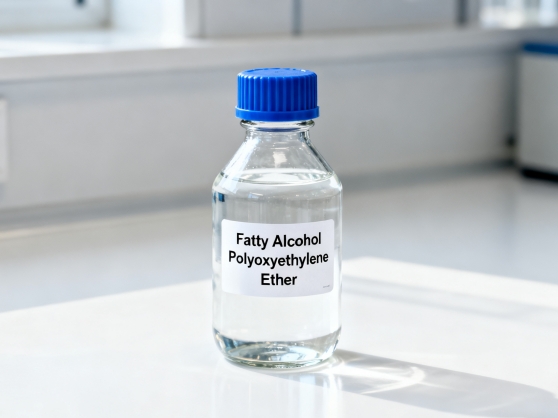
Fatty alcohol polyoxyethylene ether—commonly known as fatty alcohol ethoxylates (AEO) or emulsifier AEO—is a class of non-ionic surfactants produced by the addition reaction between fatty alcohols and ethylene oxide. The reaction introduces polyoxyethylene (EO) chains to the hydrophobic fatty alcohol structure, giving it both lipophilic and hydrophilic characteristics.
With the CAS number 68439-51-0, this surfactant group is widely valued for its excellent emulsifying, wetting, dispersing, cleaning, and solubilising performance. As a non-ionic surfactant, it maintains stable behavior in acidic, alkaline, and hard-water environments and is compatible with a large range of formulation systems.
Fatty alcohol polyoxyethylene ether is soluble in water and many organic solvents, produces moderate foam, rinses easily, and leaves minimal residue. These characteristics make it a versatile ingredient in textile auxiliaries, household detergents, metalworking fluids, and emulsion polymerization.
Fatty alcohol polyoxyethylene ether is popular across industries because it delivers a combination of performance advantages rarely found in a single surfactant type:
● Excellent Emulsifying Ability
The EO chains provide strong hydrophilicity while the fatty alcohol segment offers lipophilicity, enabling the surfactant to form stable oil-in-water emulsions. It is particularly effective in formulations requiring uniform dispersion of oils or hydrophobic substances.
● Strong Wetting and Penetration
AEO surfactants reduce surface tension efficiently, allowing water or chemical solutions to spread quickly across surfaces. This property is crucial in textile scouring, metal cleaning, and dyeing processes that require deep fiber penetration.
● Effective Detergency and Cleaning
Their balanced HLB structure provides good removal of oils, waxes, and dirt. This makes them a key component in laundry detergents, shampoos, and personal-care cleansing products.
● High Stability in Various Conditions
AEO products maintain performance in:
● Moderate Foam and Easy Rinsing
Unlike many anionic surfactants, fatty alcohol polyoxyethylene ethers create controlled foam levels and rinse out easily, which is important for washing powders, liquid detergents, and metalworking fluids.
Fatty alcohol polyoxyethylene ethers are classified based on the number of ethylene oxide (EO) units in the molecule—commonly labeled as AEO1, AEO2, AEO3, AEO5, AEO7, AEO9, AEO10, AEO23, etc.
Low EO (AEO1–AEO3):
Low HLB values, more oil-soluble, suitable for low-foaming emulsification, industrial cleaning, and metal processing fluids.
Medium EO (AEO5–AEO7):
Balanced HLB values, excellent wetting and penetration, widely used in textile scouring and dyeing auxiliaries.
High EO (AEO9–AEO23):
High HLB values, strongly water-soluble, ideal for detergents, personal care products, and emulsion polymerization.
The Hydrophilic-Lipophilic Balance determines whether the surfactant performs better as a detergent, emulsifier, solubilizer, or wetting agent. This makes selecting the correct AEO grade essential for achieving optimal formulation performance.
One of the biggest advantages of fatty alcohol polyoxyethylene ether is its broad compatibility. As a non-ionic surfactant, it can be blended with:
● Anionic Surfactants
Examples: LAS, LABSA, AES, SLES
● Cationic Surfactants
Although many anionic/cationic pairs are incompatible, AEO can mix with cationic agents without causing precipitation. This is beneficial in softeners, antistatic agents, and disinfectants.
● Amphoteric Surfactants
Examples: Betaine (CAB), Amine oxide
● Other Non-ionic Surfactants
AEO blends well with other ethoxylated alcohols, fatty acid esters, or alkyl polyglucosides (APG) to fine-tune HLB or reduce irritation.
This versatile compatibility allows formulators to adjust system properties such as foam level, cleaning strength, viscosity, and emulsification stability.
Fatty alcohol polyoxyethylene ethers are widely regarded as safe and mild compared with harsher anionic surfactants. Key attributes include:
● Low Irritation
They are gentle on skin and eyes, making them suitable for use in personal-care items such as shampoos and shower gels.
● Biodegradability
Fatty alcohol ethoxylates originate from fatty alcohols, which can be derived from natural sources such as coconut or palm kernel oil. Many AEO products are readily biodegradable under aerobic conditions.
● Low Toxicity
They demonstrate low aquatic toxicity when used within recommended concentration ranges.
● Stable but Not Bio-accumulative
AEO surfactants resist oxidation and hydrolysis during use but do not tend to accumulate in the environment.
Together, these characteristics make fatty alcohol polyoxyethylene ether a trusted choice in industries prioritizing safe, mild, and environmentally responsible formulations.